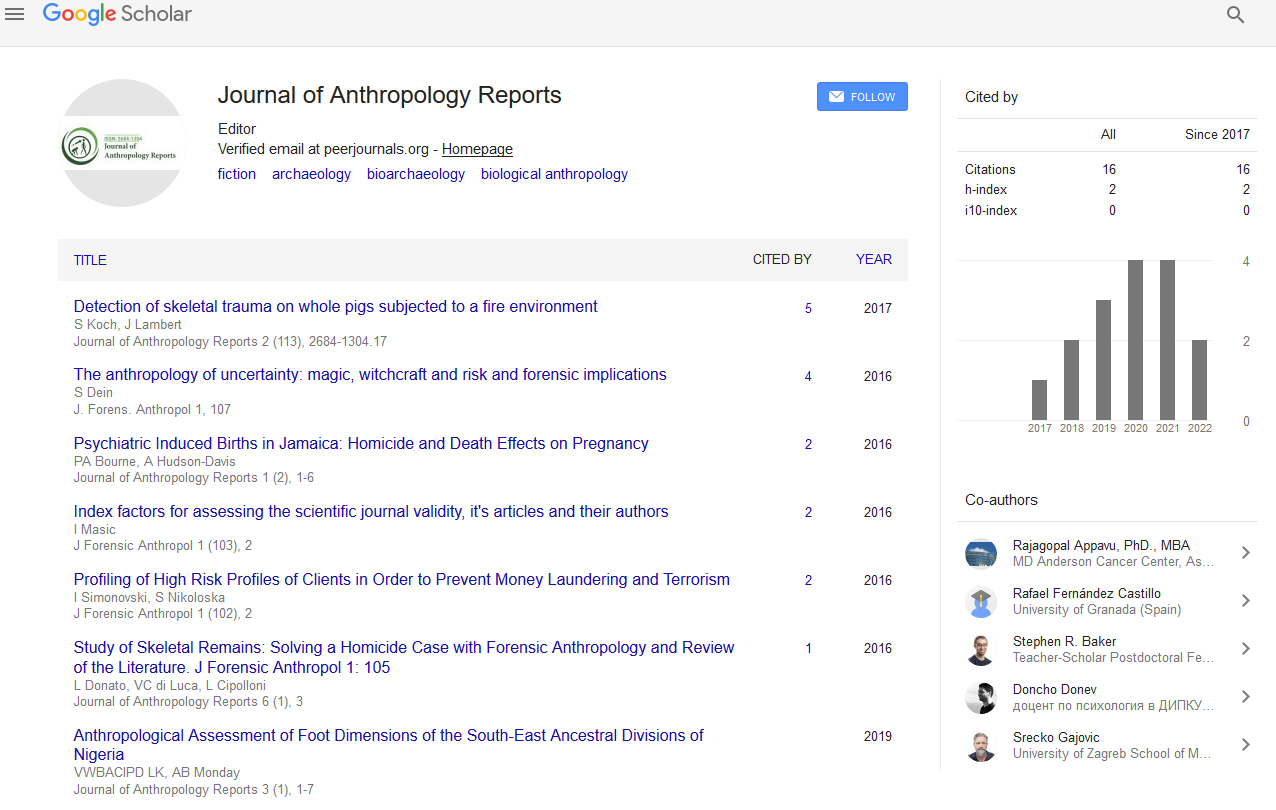Indexed In
- RefSeek
- Hamdard University
- EBSCO A-Z
Useful Links
Share This Page
Journal Flyer

Open Access Journals
- Agri and Aquaculture
- Biochemistry
- Bioinformatics & Systems Biology
- Business & Management
- Chemistry
- Clinical Sciences
- Engineering
- Food & Nutrition
- General Science
- Genetics & Molecular Biology
- Immunology & Microbiology
- Medical Sciences
- Neuroscience & Psychology
- Nursing & Health Care
- Pharmaceutical Sciences
Commentary - (2022) Volume 5, Issue 4
Analysis of Children being used as Victims of Violent Crimes
Spiroas Jankwig*Received: 22-Jun-2022, Manuscript No. JFA-22-17380; Editor assigned: 24-Jun-2022, Pre QC No. JFA-22-17380(PQ); Reviewed: 08-Jul-2022, QC No. JFA-22-17380; Revised: 15-Jul-2022, Manuscript No. JFA-22-17380(R); Published: 22-Jul-2022, DOI: 10.35248/2684-1304.22.5.132
Description
Murders and killings
The oldest instance in this article concerned a public controversy that took place in Bengal during British administration in the 19th century. The case was known as Queen v. Nobin Chandra Banerjee (1874) and in it Nobin Chandra a government employee, was accused of beheading his wife Elokeshi in retaliation for her extramarital relationship with the Brahmin head priest or Mahant of the Tarakeshwar temple. The case was sent to the Hooghly Sessions Court in Serampore and throughout the entire trial the Court had changed into a "theatre." The media played a significant role in the case's growing notoriety.
In order to assure that his wife belonged to him Nobin Chandra according to the defence attorney did the act in a fit of wrath [1]. It was asserted that Nobin sought to shield Elokeshi and remove her from her parent's home whom the priest controlled after Elokeshi told the defendant about her deeds. However, when the latter learned of these schemes his thugs stopped the move from taking place which led to Nobin Chandra killing his wife. Following that Nobin went to the Police to report his offences.
This case, State of Orissa Ram Bahadur Thapa was highly peculiar (1959). Ram Bahadur Thapa worked for J.B. Chatterjee at the Chatterjee brothers firm in Calcutta. They had travelled to the village of Rasgovindpur in the Balasore district of Orissa in order to purchase scrap from a defunct airport that was located there[2]. Visitors were informed that the region was considered haunted by the locals. Late at night as they travelled to the airfield they spotted a flickering light within the facility that appeared to be moving due to the heavy winds [3]. Thapa jumped into action and lunged at the "ghosts" with his khukri. They turned out to be native Adivasi women who had gathered under a mahua tree to pick flowers and were equipped with a hurricane light. Thapa was accused of violating Sections 302 murder 326 grievous injuries with dangerous weapons and 324 hurt with dangerous weapons of the Penal Code after injuring two women and killing another. The Sessions Judge ruled that the accused committed the acts while acting under a genuine mistake of fact believing that he was attacking ghosts rather than people [4]. The Sessions Judge based his decision to acquit the accused on Section 79 which discusses acts that are thought to be legal because of a mistake of fact. Through an appeal to the Supreme Court the petitioners disputed this, arguing that this incident could have been avoided with more care and caution. The Court however, rejected these arguments and ruled that Ram Bahadur Thapa needed to get Section 79 protection.
Cases
In Maharashtra, a woman by the name of Anjanabai trained and encouraged her family to mistreat and murder young children in order to make money. When her two children Renuka Kiran Shinde, age 29 and Seema Mohan Gavit age 25 as well as Renuka's husband Kiran Shinde, were detained in 1996 the entire incident came to light. The three were charged with kidnapping and murdering kids especially those under the age of five along with Anjanabai [5]. Despite being accused of kidnapping and murdering nine children between 1990 and 1996, they were ultimately only charged with five homicides.
The sisters were able to abduct kids from a number of Maharashtra's major cities and they kept the kids at their home in Pune. The sister’s method of operation was simple: they would bring the youngster along with them while engaging in petty theft and purse snatching, frequently preferring to do it physically. When the kids cried drew attention to them or were too big to be carried in their arms, they were killed. The sisters frequently killed these kids in the most heinous and terrible ways possible, including by bashing the kid's head against a wall until died. The Supreme Court stated in its decision to impose the death penalty on the accused that it had done so after carefully weighing the fact that the defendants posed a danger to society and had no prospect of being changed.
REFERENCES
- Lewis JH. The mental health of crime victims: Impact of legal intervention. J Trauma Stress.2003;16(2):159-166.
[Crossref], [Google Scholar], [PubMed]
- Coker D. Crime control and feminist law reform in domestic violence law: A critical review. Buffalo Crim Law Rev.2001;4(2):801-860.
[Crossref], [Google Scholar]
- Lochner L. Individual perceptions of the criminal justice system. Am Econ Rev.2007;97(1):444-460.
[Crossref], [Google Scholar], [PubMed]
- David MS, Prinz RJ. Children who murder: a review. Clin Child Fam Psychol. Rev.2000;3(2):97-115.
[Crossref], [Google Scholar], [PubMed]
- Levitt L, Hoffer TA, Loper AB. Criminal histories of a subsample of animal cruelty offenders. Aggress Violent Behav.2016;30:48-58.
[Crossref], [Google Scholar]
Citation: Jankwig S (2022) Analysis of Children being used as Victims of Violent Crimes. J Anthropology Rep. 5:132.
Copyright: © 2022 Jankwig S. This is an open access article distributed under the terms of the Creative Commons Attribution License, which permits unrestricted use, distribution, and reproduction in any medium, provided the original author and source are credited.

